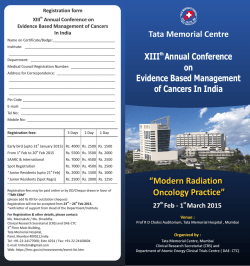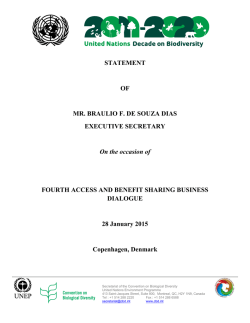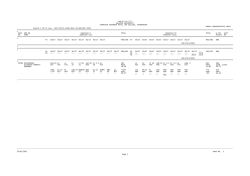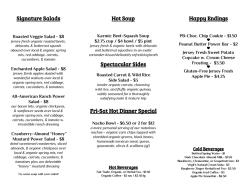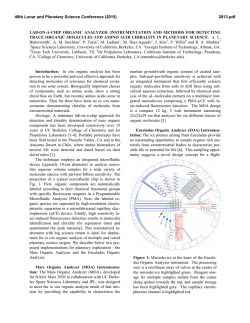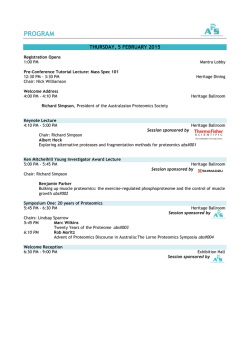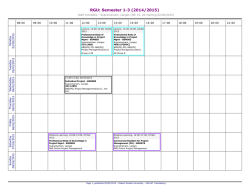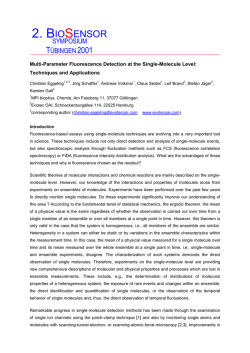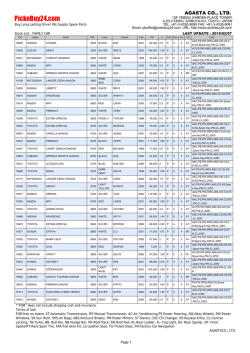
effect of high electron radiation doses on the preservation of
46th Lunar and Planetary Science Conference (2015) 1223.pdf EFFECT OF HIGH ELECTRON RADIATION DOSES ON THE PRESERVATION OF ANTIGENIC STRUCTURES OF BIOMOLECULES: IMPLICATIONS FOR LIFE DETECTION ON MARS . V. Parro1, Y. Blanco1, G. de Diego-Castilla1, A. F. Davila2, M. Moreno-Paz1, I. Gallardo-Carreño1, C. Stoker2, and C. P. Mckay2. 1Centro de Astrobiología (INTA-CSIC), Carretera de Ajalvir km4, Torrejón de Ardoz, Madrid, Spain, [email protected], 2NASA-Ames Reasearch Center, Moffet Field, CA, USA. Introduction: The proposed Icebreaker mission to Mars seeks to find organic biosignatures in ice-rich soils of the northern plains, where transient habitable conditions might have occurred within the last 1 Myr, during high obliquity cycles [1]. However, in the absence of a planetary magnetic field, organic biosignatures generated during such recent spurs of biological activity could still undergo severe radiolytic degradation, leading to a partial or complete loss of biological information [2]. This constrains the approaches used to search for evidence of life. The Signs of Life Detector (SOLID) Instrument, a component of the Icebreaker mission science payload, has been developed to search for a specific suit of organic biosignatures using Fluorescence Sandwich Immunoassay (FSI). In a FSI, purposely selected Antibodies (Abs) recognize and bind to desired biomarkers or Antigens (Ag) with high specificity [3]. Abs recognize and bind to a small region of the Ag, called the epitope. In principle, because epitopes are comparatively small, they are more likely to be preserved than entire organic biosignatures, and yet they retain discriminatory molecular information. However, few studies exist on the effects of high energy radiation on epitopes during time scales equivalent to recent obliquity cycles on Mars. Objectives: The objective is to test whether biological polymers such as proteins and peptides can still be detected by an immunoassay after exposing to 1 to 10 equivalent My martian radiation doses. We consider the radiation measurements taken by the MSL mission as the most accurate and realistic on the surface of Mars, being 0.21 mGy/day [4]. Experimental design: Representative organic biosignatures targeted by SOLID, including proteins, peptides, exopolymeric substances (EPS), and a generic L-amino acid group conjugated to a protein, were immobilized onto epoxy-activated microscope slides (Figure 1) in a microarray format. Each slide was then directly exposed to several electron radiation doses: 0, 1, 50 and 500 kGy with an energy of 10 MeV, equivalent to 0, 0.02, 1 and 10 My radiation exposure within the top 1 meter of the martian surface. After radiation exposure, we tested whether the immobilized biomolecules still retain intact or at least recognizable epitopes by the Abs. This was done by a direct immunoassay incubating the microarray with the corresponding fluo- rescently labeled Abs at 1/1000 (2 µg/ mL) as working dilution. As a positive control and reference we used slides containing the same organic biosignatures, but not exposed to radiation. After incubation and washing, each slide was scanned for fluorescence (GenePix Array Scanner) and the fluorescent intensities were analyzed and plotted as reported [3, 5]. Figure 1. Experimental setup. (A) several biomolecules (e.g. proteins, peptides, EPS…) were printed (150 microns diameter spots) onto microscope slides in 24 microarray replicates per slide. This format allowed to assay up to 12 different Abs by duplicate. (B) multiple printed slides (blue box), and soil pills spiked with B. subtilis (0.3 g in 10x0.5 mm pills). (C) Microscope slides darkening before radiation (0) and after 1, 50 and 500 kGy dose exposure. (D) Explanation of radiation effect at molecular level and detection witth fluorescent (F) antibodies. Aditionally, soil samples from the Antarctic Dry Valleys were spiked with 107 espores/g from the Gram-positive Bacillus subtilis with and without perchlorate. The samples were then compressed into 10x0.5 mm pills and subjected to the same radiation as the biomolecules (see above). One aliquot of the sample was resuspended in water by vortexing and then plated onto agar nutrient broth for viable spore counting. Another aliquot was extracted by ultrasonication into 1.5 mL of extraction buffer following the SOLID instrument procedure [3]. Then, the extract was analyzed by FSI with a microarray containing the corre- 46th Lunar and Planetary Science Conference (2015) sponding Abs. Fluorescence was quantified and ploted for comparison (Figure 3). Results: Fluorescent Abs can only bind to their corresponding antigens if these still have intact or little modified epitopes. Therefore, bright fluorescent spots indicate that the organic biosignatures still retained intact epitopes after radiation exposure, and could be recognized by the Abs. Effect of electron radiation on immobilized biomolecules. The fluorescent signal from each tested organic biosignature was observed to decrease with radiation dose, indicating damage to the epitope structure. The extent of the damage seemed to depend on epitope complexity, with smaller and simpler ones being less affected than larger ones. However, in most cases 10 to 50% of the original fluorescence signal was retained after 50 kGy (equivalent to 1My exposure), and 1 to 20% of the original fluorescence (depending the type of molecule) was retained after 500 kGy (i.e. 10 My exposure). This implies that a significant fraction of Abs could still bind to intact or partially damaged epitopes (Figure 2). 1223.pdf needed with more simple biomolecules such as protein and peptides to fully understand the effects of radiation on organic biosignatures. Figure 3. B. subtilis spores were detected by sandwhich immunoassay after 500 kGy electron radiation (blue) even in the presence of 20 mM perchlorate. +per, with perchlorate. Discussion: The Icebreaker mission seeks to find organic biosignatures in ice-rich soils of the northern plains of Mars, where biological activity might have been possible in the last 10 Myrs. At these time-scales the SOLID instrument can still recognize epitopes indicative of organic biosignatures, including antigens of bacterial spores killed by radiation exposure. However, in the absence of any biological repairing system, organic biosignatures are likely to be unrecognizable due to radiation damage in time-scales >10 Myr. Figure 2. Effect of radiation dose on the immunological detection of biomolecules. Ploting the loss of fluorescence as a function of the radiation dose compare to the blank (no radiation, 100% intensity). Effect of electron radiation with and without perchlorate on bacterial spores. Although samples were completely sterilized after 50 kGy (not a single viable spore was recovered), the anti-B. subtilis spore Abs detected a similar amount of antigenic material as the reference in 1 kGy samples (Figure 3). Even after 500 kGy we still recorded 30% of the fluorescent signal, indicating that there were still intact epitopes that could be recognized by Abs even after the death of the organisms. No additional effects were observed in the presence of 20 mM perchlorate (10 times higher than that found in Phoenix landing site). More studies are References: [1] McKay et al., (2013) Astrobiology, 13, 334353. [2] Dartnell et al., (2007) GRL 34, L02207, doi:10.1029/2006GL027494. [3] Parro et al., (2011) Astrobiology 11, 15-28. [4] Hassler et al., (2014) Science 343, 1244797-1. [5] de Diego-Castilla G. et al. (2011) Astrobiology 11, 759-73. Ab to generic L-aa was provided by Dr. Oliver Hofstetter, Northern Illinois Univeristy, DeKalb. Additional Information: Funded by Spanish Ministry MINECO No. AYA2011-24803.
© Copyright 2026


